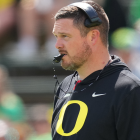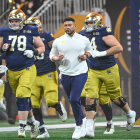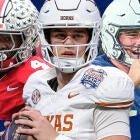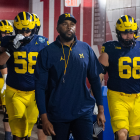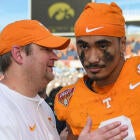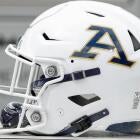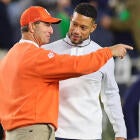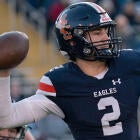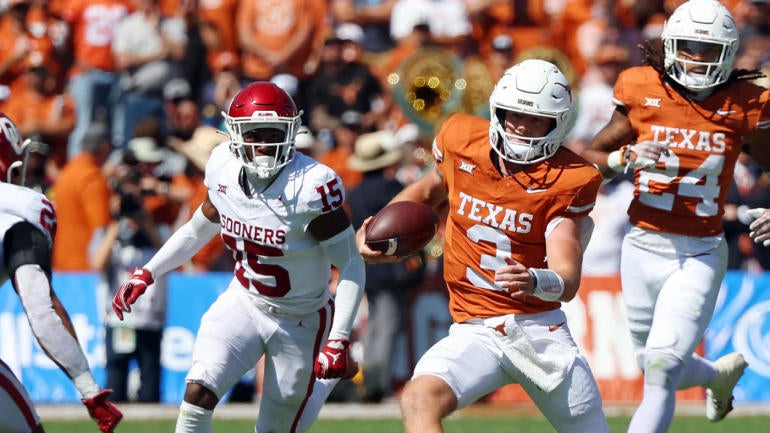
We've gathered at this place in history to assess perhaps the most significant migration of programs that's ever occurred in college football. Realignment has never seen anything like this despite its long, cluttered, painful history. Beginning on Monday, it's real and it's spectacular: Texas and Oklahoma are not only playing up a class but playing by a different set of rules in the SEC.
"It's probably like one silverback gorilla now running around with a bunch of other ones," Texas president Jay Hartzell told CBS Sports.
How this romp by apex primates turns out is one of the biggest questions entering the 2024 season and beyond. Way beyond. This isn't just another two-step out a conference side door. What you see before you are lifetime decisions made coldly, calculating and strategically over a period of years.
When word leaked in summer 2021 that Texas and Oklahoma were playing footsie with the SEC, it shocked the industry. As it turned out, that was just the opening act for the latest round of conference realignment that has consolidated power, brands and interest in the SEC and Big Ten.
Texas and Oklahoma were destined for the SEC. The geography, the passion, the culture, the smack talk, even the politics -- when you get down to it -- match.
Now, what about the football thing?
"They both know the climate they're jumping into," Georgia coach Kirby Smart said.
Do they? There's something to be said for the actual grind of playing week-to-week in the Strength Everywhere Conference. The last last two additions, Missouri and Texas A&M, have combined for two SEC Championship Game appearances -- both of which featured the Tigers. While Mizzou looks College Football Playoff worthy this season under the new 12-team format, Texas A&M's last conference title remains back in 1998 as a member of the Big 12.
"That's what I've seen studying the last six months," Oklahoma coach Brent Venables said. "Whoever those teams are that maybe didn't have a shiny record at the end of the year, it's [still] a dogfight week in, week out.
"Oklahoma doesn't sneak up on anybody, so we're not going to surprise anybody."
It's hard to recall the Big 12 was arguably the sport's dominant conference when it formed in 1996 because it united Texas and OU with the likes of Nebraska and Texas A&M. Since then, Texas and OU football has been good, sometimes great in the Big 12. The Longhorns and Sooners combined to win 18 of 28 football championships in their old league.
They were more dominant in the Big 12 boardroom, however, while dictating policy and projecting power.
In the SEC, they might arguably be the fourth or fifth-best program.
"My running joke is I have one conference where they won't listen to me [Big 12] and I can vote and another conference where they listen to me and I can't vote," Hartzell said before the switch.
The two programs have combined for 11 national championships. Texas comes in armed with the most recent bonafides, having won the Big 12 and making its first CFP appearance last season. What's more, a big reason for the 'Horns making the playoff was a double-digit win over Alabama in September.
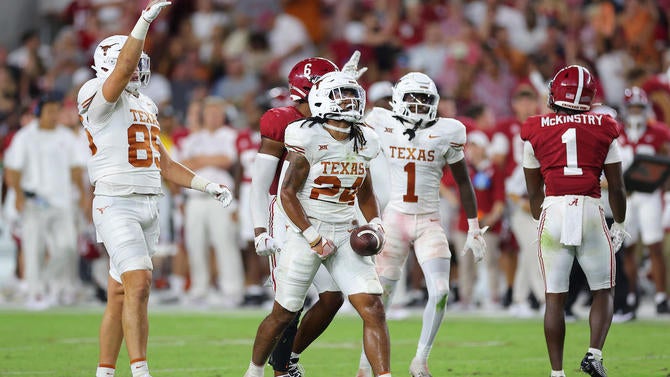
Big time met big time, and 'Bama -- maybe even the SEC as a whole -- might have blinked that weekend.
"We rolled into the Embassy Suites, it was $2,800 a night for a three-night minimum," Texas athletic director Chris Del Conte said of the fan hotel that weekend. "They took full advantage of the Longhorns rolling into town. At one point, we had 52 jets that could not land in Tuscaloosa. When we come to a game it's an armada, folks that come. You'll see it.
"Everyone says, 'They can't make it, they can't do it,'" Del Conte added. "Watch, you'll see. … We're ready."
Both programs have recovered from near disastrous starts by their current head coaches. Venables went 6-7 in his first season in 2022, the Sooners' first losing campaign since 1998. They recovered to win 10 in Venables' second season with significant improvement defensively. Steve Sarkisian went 5-7 in 2021 during his first season as Texas coach, but it's been all gas and no brakes since. The 20-7 run the last two seasons is the program's best since 2008-09.
Five years removed from having no players taken in the first four rounds of the NFL Draft, Texas had 11 players selected in April. That was second-most to Michigan (13) and most for the program since 1984.
Given the current circumstances, the answer to "Is Texas back?" now requires a thoughtful and layered response.
"The conventional wisdom is that Texas may be a year ahead of OU in that regard," said Bobby Burton, legendary national recruiting authority and host of the "On Texas Football" podcast. "Sark has an additional year on Brent Venables in rebuilding the roster, and he also has a quarterback who is a three-year starter as opposed to a new starter.
"I actually believe both teams are ready. It just depends on what your expectations are. Texas, for the last 10-15 years, has had outsized expectations versus results. OU, on the other hand, has had those expectations and probably met them, except on a national level."
Money is not an issue. Texas has the second-largest athletic budget in the country, according to USA Today ($239 million). Oklahoma is No. 10 ($177 million). The key is using that cash to help produce wins on the field, and in that regard, both schools have loaded up on the NIL front.
At Texas, construction of a new indoor facility is underway. The $400 million Moody Center is a state-of-the-art arena that houses not only Texas basketball but attracts renowned musical acts that would have skipped Austin previously. Meanwhile, Oklahoma AD Joe Castiglione continues to campaign for a $1 billion entertainment district in Norman.
Two years ago, Venables showed CBS Sports a 3-inch (at least) binder ahead of his first season that served as the codebook in Oklahoma's transitioning to the SEC. The surrounding conversation -- if not the binder itself -- has become more urgent since that day.
"I wouldn't say a whole lot has changed," Venables said. "I think the easy thing to do is say, 'OK, now I have to get the SEC binder now.' That's not what I learned from Bob Stoops, Bill Snyder or Dabo Swinney. You need a foundation of core beliefs and things you value. You always adapt and adjust. That should never stop.
"Maybe doing it more with less. I love that part of the profession. There's plenty of amazing coaches and programs to learn from. We take a humble approach but still reference that same binder. Every once in a while you rip something out and insert something, but we're keeping the same binder."
This point cannot be denied: The struggle for relevance and greatness on the national stage, as glorious as it may be in the SEC, just became a lot more difficult than in the Big 12.
"They probably are [ready]," said Cover 3 Podcast co-host and 247Sports analyst Bud Elliott. "Now, are they going to go in there and go 12-0 or 11-1 or even 10-2? That would be a tall ask. I think Texas is slightly better than Oklahoma. I don't think the SEC did Oklahoma any favors [with its schedule]."
Ah yes, the schedule which is now among the toughest in the game for the newbies. In addition to playing at Michigan this season, Texas gets Mississippi State, Georgia, Florida and Kentucky at home. The road games are at Vanderbilt, Arkansas and Texas A&M.
Oklahoma has only three SEC home games -- Tennessee, South Carolina and Alabama. The road games are at Auburn, Ole Miss, Missouri and LSU.
That's really how all this started, actually -- the schedule. Hartzell told CBS Sports he commissioned a study of football revenue in 2021 after firing ex-coach Tom Herman. If Texas was going to keep spinning its wheels, it was at least going to do it against the best.
It's fair to trace part of Texas' move back to a 54-page report from 2001 chronicling how the Boston Celtics' on-court performance impacted revenue. It was Hartzell's first published paper for the then-assistant professor for finance at New York University's Stern School of Business.
Buried in the detailed analysis from 23 years ago is this simple passage: " … winning may lead to better game attendance and, therefore, more attendance."
Ya think?
"I had this belief that winning and losing is correlated revenue," Hartzell recounted. "It's correlated but it's bumpy. You see these blips when Notre Dame came to town [2016], LSU came to town [2019]. It's millions [more in revenue]. One big home game is a huge driver in the entire season.
"So then you get Georgia, Florida and you name it [coming in]. The home game part is something that's been undiscussed. For us, it's the straw that stirs the drink."
What Hartzell didn't say, but could have, was that playing the likes of Iowa State, Kansas and West Virginia in the Big 12 wasn't cutting it. Texas' biggest rivalry game, the Red River Rivalry vs. Oklahoma, was played at a neutral site. Texas A&M wasn't coming to Austin anytime soon after departing for the SEC in 2012.
Texas was increasingly motivated to fill the nation's eighth-biggest college venue (Darrell K. Royal-Texas Memorial Stadium, 100,119). Del Conte has spoken often about a 2018 federal law that removed tax exemptions from premium tickets.
The colorful administrator, who even casual acquaintances call "CDC," had already entered into an informal scheduling agreement with his peers at Florida, Georgia and Alabama for nonconference games. Getting a shot at the SEC improved the prospects.
"When they didn't waive the deduction, it became an entertainment spend and we went quick [to a better schedule]," Del Conte said.
Having spent three years at Alabama as an analyst and offensive coordinator, winning a national championship and the Broyles Award as the nation's top assistant, Sarkisian is ready for the move up in weight class. When the transition was announced, he immediately started investing in "large humans" along both lines (his words) and elite speed on the perimeter (edge rushers and receivers).
Following 2021, Sarkisian landed quarterback Quinn Ewers in the transfer portal while nabbing the nation's top-rated offensive line. The 'Horns have produced the top running back selected in each of the last two drafts (Jonathon Brooks and Bijan Robinson). The defense improved markedly under coordinator Pete Kiatkowski. Sark also went all in on special teams coach Jeff Banks, snatching him away from Alabama.
Ewers has shaped himself into a Heisman Trophy favorite as he enters his third season. Perhaps more surprising is convincing former No. 1 overall recruit Arch Manning to back up Ewers for a second straight year. By the end of 2024, Texas will have won with quarterbacks who started their careers in the Big Ten (Ewers, Ohio State), continued through the Big 12 and ended in the SEC.
Del Conte was crowing during SEC spring meetings about his athletic department's overall accomplishments. Texas claimed its third Learfield Directors' Cup last month indicating overall excellence. The Longhorns won a Big 12 record 15 conference championships throughout the 2023-24 athletic calendar.
Entering his third season, Venables still has to prove himself a bit. The administration is on board, having recently signed its coach to a new six-year deal that essentially translates to a two-year extension.
But let's be honest: At both schools, you're only as good as your last football season, especially in a league where administrators have not shied away from paying massive buyouts to move on from coaches.
Former OU regent Max Weitzenhoffer has been a Sooners fan since the Bud Wilkinson days.
"I have not seen such anticipation for a season since [Barry] Switzer years," he told CBS Sports.
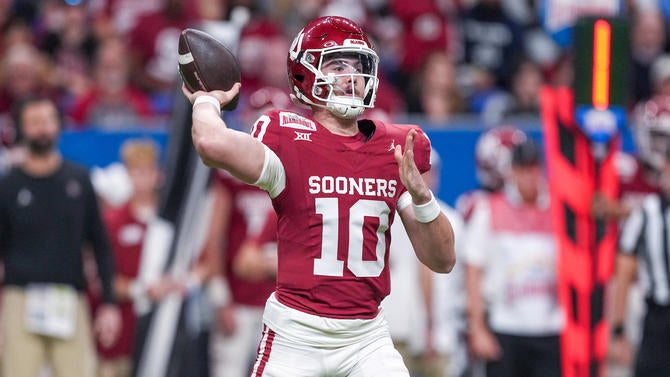
Elliott recently provided a revealing look at the pair's future in his annual Blue-Chip Ratio analysis which calculates how likely teams are to win the national championship based on recent recruiting efforts. Texas and Oklahoma are both on his list of 16 schools.
The SEC and Big Ten being enhanced by realignment has given us a different peek at that future. Consider Oct. 12. In addition to Texas vs. Oklahoma, the following conference showdowns will also be featured across the two leagues:
- Ole Miss at LSU
- Florida at Tennessee
- Washington at Iowa
- Ohio State at Oregon
- Penn State at USC
That slate summarizes why realignment occurred in the first place. The more brand-on-brand matchups, the better.
Texas has always known how a situation was going to end up before it started. Crank the wayback machine far enough and you'll remember both schools were "30 seconds away" from joining the Pac-10 in 2010 during a massive raid attempted by former Pac-10 commissioner Larry Scott.
Eventually snuffing out the pursuit was Texas' desire to keep/launch the Longhorn Network in 2011 and not be part of the Pac-12 Network. Coming full circle, LHN went dark Monday as a full-fledged cable network. An online entity with the same name re-emerged on Monday with 13 years' worth of LHN content.
For the full Longhorn experience, you'll have to watch the SEC Network. That's not only OK, but it's a reason Texas and OU will soon be cashing media rights checks for at least $60 million annually.
It can be argued that stiff-arming the Pac-10 14 years ago ultimately led to that conference's collapse which became official itself on Monday. The SEC's acquisition of the 'Horns and Sooners forced the Big Ten to make a corresponding move by nabbing UCLA and USC. The Pac-12 was put to eternal rest when Oregon and Washington decided to migrate to the Big Ten last August.
Was it all just preordained by market forces, maybe? In that sense, it's not worth arguing whether Texas instigated the move to the SEC and Oklahoma had no choice but to follow.
A school is either "additive" or "derivative" in realignment. In this case, Texas and Oklahoma are perhaps the most additive members in the history of realignment.
Since 2013, Oklahoma is eighth and Texas is 10th in total combined regular-season viewers, according to the Altimore Collins & Company consulting agency. Among the top 15 on that list, Texas and OU are the only schools to move from one power conference to another in this current round of realignment.
That would suggest some sort of closure on the school-hopping front. But since that maddening day three years ago, it has become a mad rush to join the SEC or Big Ten. Florida State and Clemson may continue the trend with both having sued the ACC challenging what seems like an intractable grant of rights. More may follow.
At the heart of this particular move has to be some sense of hubris. SEC superiority has been projected in different forms for years. It is an exclusive club. In a sense, outsiders are not allowed, or they at least must undergo a significant football indoctrination. Since 2009, four schools have won SEC championships: Alabama, Auburn, Georgia and LSU.
There's a reason Texas and Oklahoma were granted access to this exclusive club, though. They belong. Their history, culture and smack talk do blend with the SEC. There shouldn't be a "proof of concept" required here. Texas could win the league this year.
So part of this has to be the SEC getting used to Texas and Oklahoma as well. Life between the southern football lines isn't going to get easier for anyone with the two powerhouses elbowing their way into the fold.
Cue those silverbacks.
"This is a league that is a very unforgiving league," Venables said.
"Adapt or die," Sarkisian concluded.
![[object Object] Logo](https://sportshub.cbsistatic.com/i/2020/04/22/e9ceb731-8b3f-4c60-98fe-090ab66a2997/screen-shot-2020-04-22-at-11-04-56-am.png)








